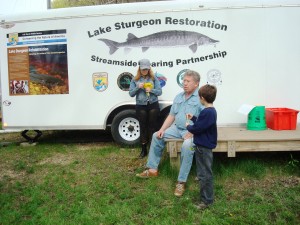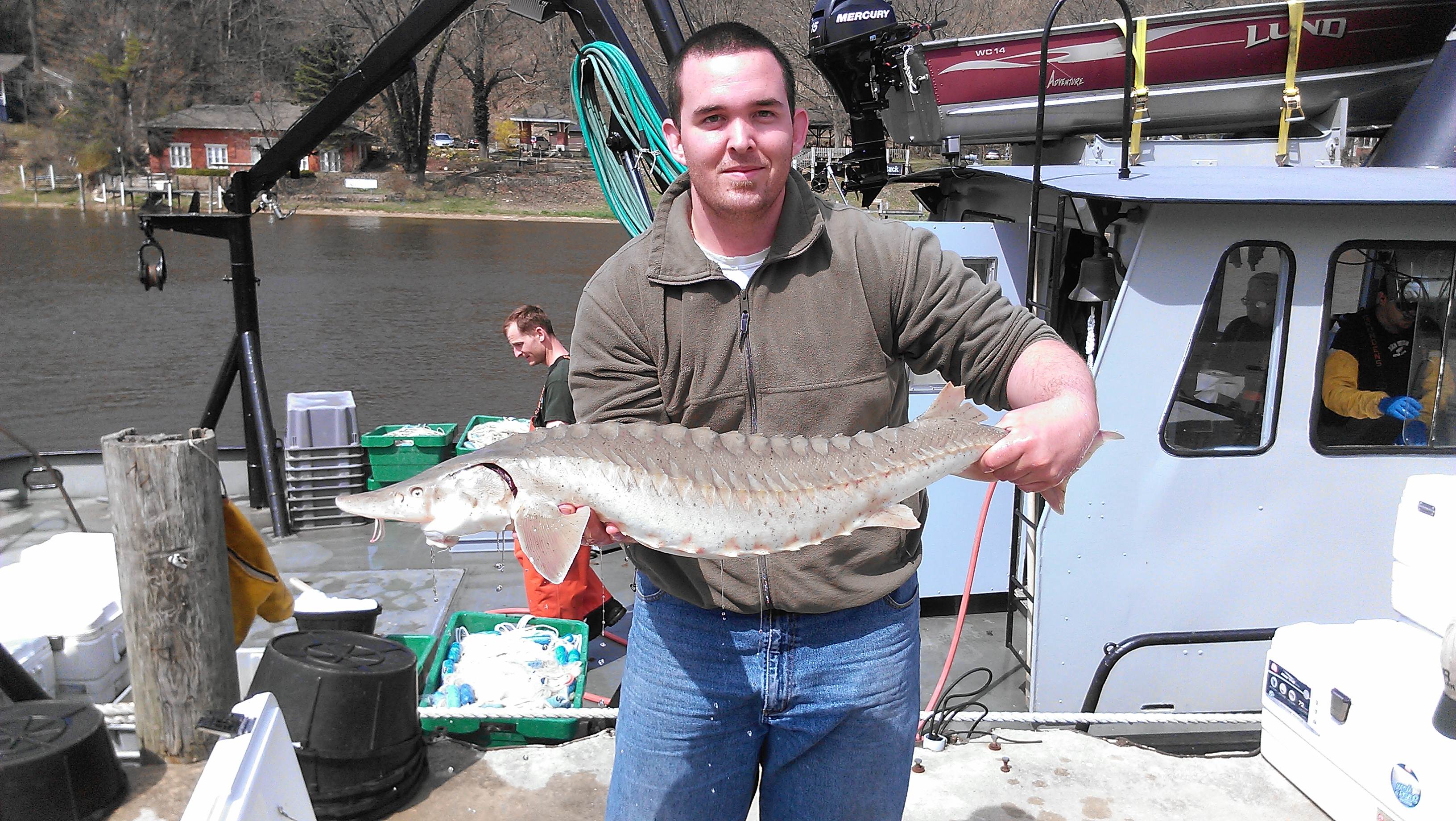
Gun Lake Tribe Environmental Technician Jason Lorenz wrangles a lake sturgeon captured while monitoring the Kalamazoo River. Image: Courtesy Gun Lake Tribe
By Talli Nauman
DORR, Mich. — For generations untold, a colossal fish known as the name (pronounced nah’ may) was crucial to survival for the indigenous people of the Great Lakes region. Well-worn paths lead to spawning grounds at the sandbar where Bear Creek meets the Kalamazoo River in Southwest Michigan.
Here, the Match-E-Be-Nash-She-Wish Band of the Pottawatomi Indians of the Gun Lake Tribe once brought whole families to spear the seasonal catch.
The intriguing ancient underwater species — whose proportions (up to at least 200 pounds) and longevity (up to at least 100 years) warrant many a myth — came to be called lake sturgeon, valued by non-Indians for trophy fishing and caviar, as well as by Native Americans.
“The sturgeon is the highest order of our clan system; in the old days we would take our hereditary chiefs from the sturgeon clan, because the sturgeon is a sacred animal,” said tribal elder Sydney Martin, 70, a native of Bradley, Mich. “It is the one who intercedes for us to the creator, specifically on the weather, making it storm or rain or snow.”
The word for prayer in the Pottawatomi language of Anishinabek is related to the word for sturgeon: “nama”.

Inside the portable hatchery at Richmond Bridge County Park, U.S. Fish and Wildlife Service fisheries biologist Elliott Kittel demonstrates the nest where sturgeon eggs hatch in captivity. Photo: Talli Nauman
Sturgeon linked to Native American culture
Without the sturgeon, no Pottawatomi would remain in Michigan today, Martin wagers. In the 19th Century’s Trail of Tears era, federal policies forced tribal members to move off their lands to Oklahoma and Kansas.
“When the white people came to remove us from Allegan County, our people hid out in the large woods along the Kalamazoo River and its tributaries,” she said. “When the sturgeon would come through there once a year, the Anishinabek would take those; we could dry that and we would have enough food to last our families a year.”
Decades of habitat pressures that accompanied Michigan’s settlement and development practically wiped out the endemic, or local, version of the Acipenseridae family, a fish that had endured since prehistoric times. Now considered a threatened species, its catch is limited by state law to one per angler per year, requires a special harvest tag and has other region-specific regulations.
The sturgeon’s survival — even after the 2011 Enbridge 6B Pipeline break dumped an estimated 1.1 million gallons diluted bitumen or tar-sands crude-oil into the Kalamazoo River upstream from spawning grounds — constitutes a signal, Martin said.
“We realize that is for a reason. The sturgeon is protecting the sacred river for us — not just Indians, but for the whole earth.
“They probably are doing things that none of US know anything about. They probably are cleaning the river.”
Promising future
After watching their families’ prime historical source of food and faith nearly perish from the Kalamazoo River, the authorities of the Gun Lake Tribe now are on the verge of signing an accord for a joint effort to restore the sturgeon population.
“It’s not approved by all the parties yet, but we’re still working together like it was in effect,” Gun Lake Tribe Environmental Director Elizabeth Binoniemi Smith said. “We’re expecting it to get signed very, very soon.”
The tribe is partnering with the U.S. Fish and Wildlife Service, the Michigan Department of Environment and Natural Resources, the Allegan County Parks Department, and the non-profit Kalamazoo River Sturgeon for Tomorrow to restore the remnant dinosaurs of the deep to a self-sustaining level in the waterway.
Before the project started, the Kalamazoo’s sturgeon population was estimated at no more than 30. Pollution, dams, encroachment and overfishing had ruined it.

Kalamazoo Sturgeon for Tomorrow member Ron Clark and family help supervise activities at portable streamside rearing facility. Photo: Talli Nauman
“Like our ancestors, the sturgeon was taken almost to the point of extinction,” former Gun Lake Tribal Councilor Punkin Shananaquet said. “There are accounts of the sturgeon being stacked like lumber –the meat left to rot because the effort was only to take the eggs, or the caviar, for use in the rich’s 16th – 20th Century diets.”
This spring, the restoration partnership members identified enough mature sturgeon to estimate that as many as 100 adults live in the watershed.
The small figures speak to the painstaking nature of bringing back the 200-million-year-old species from the brink of extinction. In 2012, not a single specimen was seen.
The annual migrants from Lake Michigan didn’t lay their eggs that year for a long time because the water was so warm, Gun Lake Tribe Environmental Technician Jason Lorenz said.
By May 2013, eight adults had been spotted; four small fry were growing in the rearing facility, and a couple dozen fertilized eggs were being carefully monitored.
“They don’t spawn until in their teens, so they might not be back to spawn for 15 years. Sometimes they might come up the river and not spawn,” Lorenz said. “It’s hard to see how well it’s working because it takes so long.
“Hopefully you get to see some progress from work that you’ve done before you retire,” he said.
The stewards of the Kalamazoo lake sturgeon recruit volunteers, guard against poaching, fortify stream banks, conduct research and sampling, afford personal treatment to every netted sturgeon, and fit the fish with electronic tracking devices. They collect eggs and sperm, capture larvae, and supervise fertilization and growth of hatchlings at a portable streamside hatchery located in the New Richmond Bridge County Park. They also manage the release of the fingerlings raised in captivity.
Restoration elsewhere

Gun Lake Tribe Environmental Technician Jason Lorenz and DNR Seasonal TechnicianTanner Sommerfeld pull in a net set in the Kalamazoo River to catch adult lake sturgeon.
Photo: Courtesy of Gun Lake Tribe
The Kalamazoo is one of 24 watersheds in Michigan with lake sturgeon still at large.
The Little River Band of Ottawa Indians, headquartered at Manistee, in Northern Michigan, is leading another sturgeon repopulation program. Lorenz, a member of the Sault Ste. Marie Tribe of Chippewa Indians, championed sturgeon restoration at Black Lake on the Cheboygan River, also in Northern Michigan, before joining the Gun Lake Tribe’s new effort on the Kalamazoo.
“Cheboygan and Black Lake have a good population of sturgeon, but we don’t want to bring those fish down here because they are not our Kalamazoo fish,” he said. “Fish imprint on what river they come to spawn. We raise larvae with Kalamazoo River water so they come back.”
The restoration partners’ portable hatchery, located north of Fennville and east of Saugatuck in rural Allegan County, hosted a celebration in connection with its first successful sturgeon release, returning more than 100 fish to the Kalamazoo in September 2011. A representative of the Gun Lake Tribe offered a blessing in the tradition of the Anishinabek (Potawatomi, Ojibwe, and Odawa), or Three Fires Confederacy.
Asked what successful sturgeon restoration would mean to her people, Martin, grandmother of seven and great grandmother of two, replied: “Everybody would be a lot more at peace with each other and with Mother Earth. We recognized way-back-when that sturgeons live to be 100 years old or more and they are wise.
“It would be the ideal way to live to have that knowledge back, because in knowledge there is confidence, self-sufficiency and pride that you’re contributing to life here on Mother Earth. Nothing else can do that for you: not alcohol and not drugs. It’s finding it within yourself. That’s what that sturgeon represents.”
Editor’s note: Reporting for this story was also supported by the Institutes for Journalism and Natural Resources.
